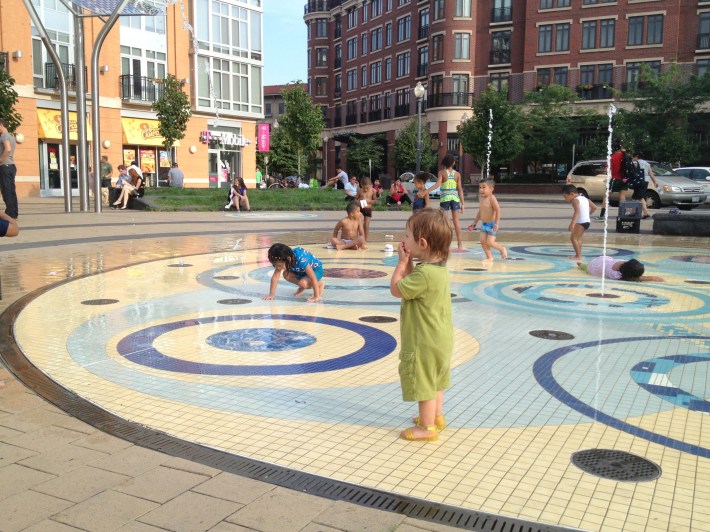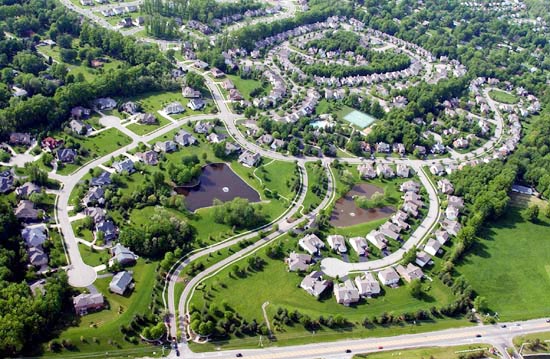Crawlable Urbanism: Cities Are for Kids, Too
11:59 AM EDT on August 13, 2013
All of a sudden, I feel like all anyone is talking about is whether it’s a good idea to raise kids in the city. I’m raising a kid in the city. I feel great about it when she has a blast on the back of the bike, or makes friends on the bus, or gets excited about pressing the beg button at the corner. I feel a little less certain when we toddle down the sidewalk and come upon guys peeing on the dumpster or passed out on the stoop. When I look at the test scores for our neighborhood schools, I get a knot in my stomach.

A few days ago I visited my friends’ new home in Potomac, a wealthy, second-ring suburb with enviable schools. Their new house sits on two acres with a pool and a basketball court. After a few hours sipping beer in their landscaped yard and watching our children frolic in the pool, I had to do some mental gymnastics to remind myself why I didn’t pick this path for myself.
This City? Childless?
But the fact is, despite its obvious allure, that path is being chosen by fewer and fewer people. Even among families with kids, many who could afford 5,000 square feet with a pool are increasingly opting for a smaller house, a pool club membership, a shorter commute, and transit access.
In the current issue of City Journal, Joel Kotkin and Ali Modarres pretty much erased this reality -- my reality, mind you -- with their silly article, “The Childless City”:
Even the partial rebirth of American cities since [the 1960s] hasn’t been enough to lure families [with kids] back. The much-ballyhooed and self-celebrating “creative class” — a demographic group that includes not only single professionals but also well-heeled childless couples, empty nesters, and college students — occupies much of the urban space once filled by families. Increasingly, our great American cities, from New York and Chicago to Los Angeles and Seattle, are evolving into playgrounds for the rich, traps for the poor, and way stations for the ambitious young en route eventually to less congested places. The middle-class family has been pushed to the margins, breaking dramatically with urban history.

“The Childless City” is illustrated with a picture -- I’m not kidding you -- of “the casts of The Real World and Jersey Shore party[ing] it up at a New York nightclub.” That, to them, illustrates the modern city.
I’d like to take Joel Kotkin on a child’s-eye tour of Washington, DC, a city emptied out a few decades ago by crack and riots and mayhem. Talk about a rebirth.
I’d bring him along to the bilingual story hour at the local library, which is walking distance even for my toddler. I’d show him parents taking the bus with their kids down to the National Mall to see dinosaur skeletons and war planes in our world-class museums. I’d encourage him to play in the fountain in the plaza of the transit-oriented neighborhood of Columbia Heights along with scores of wet, shrieking children of all colors and incomes. And after he got his soak on, I’d even buy him frozen yogurt, Chilean empanadas, vegan cupcakes, or Central American fried chicken from the establishments lining the plaza.
All of these child-friendly urban amenities are invisible to Kotkin. “We have embarked on an experiment to rid our cities of children,” he declares. The rent is too high, the yards are too small, the schools are too bad, the neighbors are too sketchy.
Indicator Species
A few months ago, Washington Post business reporter Jonathan O’Connell wondered whether DC can grow up with the 20-somethings he says have fueled its revitalization. “What D.C. hasn’t yet figured out, or even really planned for, is what happens when this raft of newcomers grows out of one-bedroom condo living,” O’Connell wrote. “What happens when their lives evolve past the urban-playground stage and they are less interested in speakeasies than in parks for their kids?”
The funny thing is, Jonathan O’Connell lives two blocks away from me. We met up at a neighborhood bar a few months ago to talk about education after he wrote a counter-intuitively glowing review of the public elementary school we’re both zoned for. I sometimes see him walking his daughter to school there. His wife helped organize a Saturday-morning Zumba class and other great programming at the shiny-new recreation center that just opened a few blocks away. If proof exists that the city can be a great place to raise a family, the O’Connells would seem to be it.
But he doesn't want his kids stepping over passed-out dudes on the sidewalk any more than I do. If he’s questioning how long his family will stick around, who am I to question his judgment? With any luck, though, he’ll continue to find the urban charms of our neighborhood and our city more compelling than its deficits.

As Vancouver planner Brent Toderian wrote recently (and others have said before), “Kids are the indicator species of a great neighborhood." Cities -- even downtowns -- aren’t just for singles and seniors. Toderian says in Vancouver, they got developers to build and sometimes even operate daycares and schools as part of “density negotiations.” And cities across North America are following suit, focusing on attracting families with kids downtown.
“Oslo, Norway mandated in 2007 that half of all new homes be sized for 3 bedrooms and families,” Toderian wrote in his article on downtown living with kids. "Minneapolis's mayor has been asking the tough questions around attracting downtown families. Edmonton, Alberta's mayor recently hoped that their development of former inner city airport lands could specifically attract families.”
Then there's the question of whether suburbs or cities afford kids and parents more freedom. Leigh Gallagher’s new book, "The End of the Suburbs," illustrates the way car-centric street design traps parents into shuttling their kids around all day instead of letting them just “go outside and do something with their friends.”
It's worth noting that parents in cities also do a lot of hand-wringing about the age at which they can let their kids in cities just “go outside and do something with their friends.” Author Lenore Skenazy set off a storm of controversy a few years back when she let her 9-year-old son take the subway in New York by himself. But do parents in “safe” suburbs let their kids ride their bicycles and scooters around by themselves? Within the gates of the subdivision, maybe. Step off the compound and you’re on a high-speed connector road without sidewalks and you’re walking miles till you get to a place that’s zoned to sell your kid an ice cream cone.
Gallagher says you can measure walkability by how much you need to spend on Halloween candy. If the kids bypass your neighborhood because it takes too long to get from one house to the next, you’ve got density problems. If you buy out CVS and don’t even have one measly Kit-Kat to yourself November 1, you’re living in a WalkScore paradise. Welcome to my world.
Stay in touch
Sign up for our free newsletter
More from Streetsblog USA
Thursday’s Headlines Don’t Like Riding on the Passenger Side
Can you take me to the store, and then the bank? I've got five dollars you can put in the tank.
Study: When Speed Limits Rise on Interstates, So Do Crash Hot Spots on Nearby Roads
Rising interstate speeds don't just make roads deadlier for people who drive on them — and local decision makers need to be prepared.
Calif. Bill to Require Speed Control in Vehicles Goes Limp
Also passed yesterday were S.B 961, the Complete Streets bill, a bill on Bay Area transit funding, and a prohibition on state funding for Class III bikeways.
Under Threat of Federal Suit (Again!), NYC Promises Action on ‘Unacceptable’ Illegal Police Parking
A deputy mayor made a flat-out promise to eliminate illegal police parking that violates the Americans With Disabilities Act. But when? How? We don't know.
‘We Don’t Need These Highways’: Author Megan Kimble on Texas’ Ongoing Freeway Fights
...and what they have to teach other communities across America.




